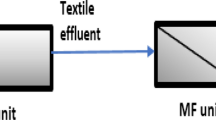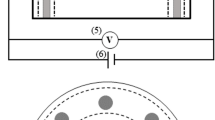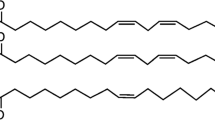Abstract
The textile industry uses large amounts of water that becomes wastewater contaminated with salts, starches, acids, peroxides, enzymes, dyes, and other pollutants. Here, we optimized the treatment of textile industry wastewater by electrocoagulation (EC) using aluminum and iron electrodes employing a response surface methodology (RSM) approach. Hence, the effects and interactions of the variables of the process (pH, current density, and reaction time) on turbidity and chemical oxygen demand (COD) removal were evaluated using the Box-Behnken mathematical model in a monopolar batch reactor. Analyses of variance were also performed to estimate model responses and optimum conditions. After determining the mathematically optimized variables of the EC process, its efficiency in the removal of heavy metals and cations from textile wastewater was also evaluated for both the electrodes under study. Experimental data yielded 89.92 and 86.38% in COD removal, and 99.75 and 97.67% in turbidity removal for Al and Fe electrodes. Moreover, the theoretical maximum removals are 93.58 and 87.08% of COD for Al and Fe electrodes and 100% of TB for both electrodes. The removal of U, As, V, Si, P, and Pb was above 90% with both electrode materials. Although both electrodes removed part of the cations, the aluminum electrodes yielded higher removals of Ca+2 and Na+1 (46.19 and 31.94%). Therefore, our study demonstrates that the RSM and Box-Behnken are suitable for optimizing the electrocoagulation process to treat textile wastewater and that the EC is an efficient technology for removing different organic and inorganic pollutants.




Similar content being viewed by others
References
Ali I, Khan TA, Asim M (2012) Removal of arsenate from groundwater by electrocoagulation method. Environ Sci Pollut R 19(5):1668–1676. https://doi.org/10.1007/s11356-011-0681-3
Aouni A, Fersi C, Ben Sik Ali M, Dhahbi M (2009) Treatment of textile wastewater by a hybrid electrocoagulation/nanofiltration process. J Hazard Mater 168(2):868–874. https://doi.org/10.1016/j.jhazmat.2009.02.112
APHA (1999). Standard methods for the examination of water and wastewater. In American Public Health Association (twentieth)
Bahadur N, Das P, Bhargava N (2020) Improving energy efficiency and economic feasibility of photocatalytic treatment of synthetic and real textile wastewater using bagasse fly ash modified TiO2. Chem Eng J Adv 2:100012. https://doi.org/10.1016/J.CEJA.2020.100012
Bajpai S, Gupta SK, Dey A, Jha MK, Bajpai V, Joshi S, Gupta A (2012) Application of central composite design approach for removal of chromium (VI) from aqueous solution using weakly anionic resin: Modeling, optimization, and study of interactive variables. J Hazard Mater 227–228:436–444. https://doi.org/10.1016/J.JHAZMAT.2012.05.016
Bayramoglu M, Kobya M, Can OT, Sozbir M (2004) Operating cost analysis of electrocoagulation of textile dye wastewater. Sep Purif Technol 37(2):117–125. https://doi.org/10.1016/J.SEPPUR.2003.09.002
Bener S, Bulca Ö, Palas B, Tekin G, Atalay S, Ersöz G (2019) Electrocoagulation process for the treatment of real textile wastewater: effect of operative conditions on the organic carbon removal and kinetic study. Process Saf Environ 129:47–54. https://doi.org/10.1016/j.psep.2019.06.010
Bilińska L, Gmurek M, Ledakowicz S (2016) Comparison between industrial and simulated textile wastewater treatment by AOPs - biodegradability, toxicity and cost assessment. Chem Eng J 306:550–559. https://doi.org/10.1016/J.CEJ.2016.07.100
Camacho LM, Deng S, Parra RR (2010) Uranium removal from groundwater by natural clinoptilolite zeolite: effects of pH and initial feed concentration. J Hazard Mater 175(1):393–398. https://doi.org/10.1016/j.jhazmat.2009.10.017
Castro M, Nogueira V, Lopes I, Vieira MN, Rocha-Santos T, Pereira R (2018) Treatment of a textile effluent by adsorption with cork granules and titanium dioxide nanomaterial. J Environ Sci Heal A 53(6):524–536. https://doi.org/10.1080/10934529.2018.1425020
Chavalparit O, Ongwandee M (2009) Optimizing electrocoagulation process for the treatment of biodiesel wastewater using response surface methodology. J Environ Sci 21(11):1491–1496. https://doi.org/10.1016/S1001-0742(08)62445-6
Choi AEES, Futalan CCM, Yee J-J (2020) Fuzzy optimization for the removal of uranium from mine water using batch electrocoagulation: a case study. Nucl Eng Technol 52(7):1471–1480. https://doi.org/10.1016/j.net.2019.12.016
Doggaz A, Attour A, Le Page MM, Côme K, Tlili M, Lapicque F (2019) Removal of heavy metals by electrocoagulation from hydrogenocarbonate-containing waters: compared cases of divalent iron and zinc cations. J Water Proc Eng 29:100796. https://doi.org/10.1016/j.jwpe.2019.100796
Esfandyari Y, Saeb K, Tavana A, Rahnavard A, Fahimi FG (2020) Effective removal of cefazolin from hospital wastewater by the electrocoagulation process. Water Sci Technol 80(12):2422–2429. https://doi.org/10.2166/wst.2020.003
Essadki AH, Bennajah M, Gourich B, Vial C, Azzi M, Delmas H (2008) Electrocoagulation/electroflotation in an external-loop airlift reactor-application to the decolorization of textile dye wastewater: a case study. Chem Eng Process 47(8):1211–1223. https://doi.org/10.1016/j.cep.2007.03.013
Garg VK, Amita M, Kumar R, Gupta R (2004) Basic dye (methylene blue) removal from simulated wastewater by adsorption using Indian rosewood sawdust: a timber industry waste. Dyes Pigments 63(3):243–250. https://doi.org/10.1016/J.DYEPIG.2004.03.005
Gasemloo S, Khosravi M, Sohrabi MR, Dastmalchi S, Gharbani P (2019) Response surface methodology (RSM) modeling to improve removal of Cr (VI) ions from tannery wastewater using sulfated carboxymethyl cellulose nanofilter. J Clean Prod 208:736–742. https://doi.org/10.1016/j.jclepro.2018.10.177
Gatsios E, Hahladakis JN, Gidarakos E (2015) Optimization of electrocoagulation (EC) process for the purification of a real industrial wastewater from toxic metals. J Environ Man 154:117–127. https://doi.org/10.1016/j.jenvman.2015.02.018
Ghanbari F, Moradi M, Eslami A, Emamjomeh MM (2014) Electrocoagulation/flotation of textile wastewater with simultaneous application of aluminum and iron as anode. Environ Process 1(4):447–457. https://doi.org/10.1007/s40710-014-0029-3
Holkar CR, Jadhav AJ, Pinjari DV, Mahamuni NM, Pandit AB (2016) A critical review on textile wastewater treatments: possible approaches. J Environ Man 182:351–366. https://doi.org/10.1016/j.jenvman.2016.07.090
Hu CY, Lo SL, Kuan WH, De LY (2008) Treatment of high fluoride-content wastewater by continuous electrocoagulation-flotation system with bipolar aluminum electrodes. Sep Purif Technol 60(1):1–5. https://doi.org/10.1016/J.SEPPUR.2007.07.040
Khorram AG, Fallah N (2018) Treatment of textile dyeing factory wastewater by electrocoagulation with low sludge settling time: optimization of operating parameters by RSM. J Environ Chem Eng 6(1):635–642. https://doi.org/10.1016/J.JECE.2017.12.054
Kim T, Kim T-K, Zoh K-D (2020) Removal mechanism of heavy metal (Cu, Ni, Zn, and Cr) in the presence of cyanide during electrocoagulation using Fe and Al electrodes. J Water Proc Eng 33:101109. https://doi.org/10.1016/j.jwpe.2019.101109
Kobya M, Demirbas E, Can O, Bayramoglu M (2006) Treatment of levafix orange textile dye solution by electrocoagulation. J Hazard Mater 132(2–3):183–188. https://doi.org/10.1016/j.jhazmat.2005.07.084
Kobya M, Bayramoglu M, Eyvaz M (2007) Techno-economical evaluation of electrocoagulation for the textile wastewater using different electrode connections. J Hazard Mater 148(1):311–318. https://doi.org/10.1016/j.jhazmat.2007.02.036
Kobya M, Can OT, Bayramoglu M (2003) Treatment of textile wastewaters by electrocoagulation using iron and aluminum electrodes. J Hazard Mater 100(1):163–178. https://doi.org/10.1016/S0304-3894(03)00102-X
Li P, Chen P, Wang G, Wang L, Wang X, Li Y, Zhang W, Jiang H, Chen H (2020) Uranium elimination and recovery from wastewater with ligand chelation- enhanced electrocoagulation. Chem Eng J 393:124819. https://doi.org/10.1016/j.cej.2020.124819
Linares-Hernández I, Barrera-Díaz C, Roa-Morales G, Bilyeu B, Ureña-Núñez F (2009) Influence of the anodic material on electrocoagulation performance. Chem Eng J 148(1):97–105. https://doi.org/10.1016/j.cej.2008.08.007
Lubis M, Fujianti D, Zahara R, Darmadi D (2019) The Optimization of the electrocoagulation of palm oil mill effluent with a box-Behnken design. Int J Technol 10(1):137. https://doi.org/10.14716/ijtech.v10i1.838
Merma AG, Santos BF, Rego ASC, Hacha RR, Torem ML (2020) Treatment of oily wastewater from mining industry using electrocoagulation: fundamentals and process optimization. J Mater Res Technol 9(6):15164–15176. https://doi.org/10.1016/J.JMRT.2020.10.107
Naje AS, Chelliapan S, Zakaria Z, Ajeel MA, Alaba PA (2017) A review of electrocoagulation technology for the treatment of textile wastewater. Rev Chem Eng 33(3):263–292. https://doi.org/10.1515/revce-2016-0019
Nasrullah M, Siddique MNI, Zularisam AW (2014) Effect of high current density in electrocoagulation process for sewage treatment. Asian J Chem 26(14):4281–4285
Paździor K, Bilińska L, Ledakowicz S (2019) A review of the existing and emerging technologies in the combination of AOPs and biological processes in industrial textile wastewater treatment. Chem Eng J 376:120597. https://doi.org/10.1016/j.cej.2018.12.057
Ratna Kumar P, Chaudhari S, Khilar KC, Mahajan SP (2004) Removal of arsenic from water by electrocoagulation. Chemosphere 55(9):1245–1252. https://doi.org/10.1016/j.chemosphere.2003.12.025
Shahedi A, Darban AK, Taghipour F, Jamshidi-Zanjani A (2020) A review on industrial wastewater treatment via electrocoagulation processes. Curr Op Electrochem 22:154–169. https://doi.org/10.1016/j.coelec.2020.05.009
Singh VK, Bikundia DS, Sarswat A, Mohan D (2012) Groundwater quality assessment in the village of Lutfullapur Nawada, Loni, District Ghaziabad, Uttar Pradesh. India Environ Mon Assess 184(7):4473–4488. https://doi.org/10.1007/s10661-011-2279-0
Tak B, Tak B, Kim Y, Park Y, Yoon Y, Min G (2015) Optimization of color and COD removal from livestock wastewater by electrocoagulation process: application of Box-Behnken design (BBD). J Ind Eng Chem 28:307–315. https://doi.org/10.1016/j.jiec.2015.03.008
Tezcan Un U, Aytac E (2013) Electrocoagulation in a packed bed reactor-complete treatment of color and cod from real textile wastewater. J Environ Manage 123:113–119. https://doi.org/10.1016/j.jenvman.2013.03.016
Zheng T (2017) Treatment of oilfield produced water with electrocoagulation: Improving the process performance by using pulse current. J Water Reuse Desal 7(3):378–386. https://doi.org/10.2166/wrd.2016.113
Acknowledgements
This work was supported by the Universidad Católica de Santa María—Vicerrectorado de Investigación-Arequipa-Perú and the Brazilian agencies CNPq (grants: 305438/2018-2 and 311856/2019-5) and CAPES (grant: 001).
Funding
Funding was received to assist with the preparation of this manuscript by Universidad Católica de Santa María—Vicerrectorado de Investigación. Conselho Nacional de Desenvolvimento Científico e Tecnológico, 305438/2018-2, Giancarlo Richard Salazar Banda, 311856/2019-5, Katlin Ivon Barrios Eguiluz, Coordenação de Aperfeiçoamento de Pessoal de Nível Superior, 001, Giancarlo Richard Salazar Banda and Katlin Ivon Barrios Eguiluz.
Author information
Authors and Affiliations
Corresponding author
Ethics declarations
Conflict of Interest
The authors declare that they have no competing interests disclose.
Rights and permissions
About this article
Cite this article
Pacheco, H.G.J., Elguera, N.Y.M., Sarka, H.D.Q. et al. Box-Behnken Response Surface Design for Modeling and Optimization of Electrocoagulation for Treating Real Textile wastewater. Int J Environ Res 16, 43 (2022). https://doi.org/10.1007/s41742-022-00419-4
Received:
Revised:
Accepted:
Published:
DOI: https://doi.org/10.1007/s41742-022-00419-4




